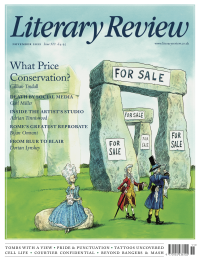Thomas Blaikie
Hair & Spare
Three Times a Countess: The Extraordinary Life and Times of Raine Spencer
By Tina Gaudoin
Constable 326pp £25
Courtiers: The Hidden Power Behind the Crown
By Valentine Low
Headline 384pp £20
Tina Gaudoin’s life of Raine Spencer has received an extraordinary amount of attention, even in the serious press, which is strange given that its subject hasn’t generated headlines for over two decades and died six years ago. So what is the significance of Raine? Her coiffure was monumental, of course, held up – like much else to do with her and her bizarre mother, Barbara Cartland – by willpower alone, apparently. A friend of mine was once in a sandwich shop in South Audley Street that served takeaways only, but then Raine appeared and turned the establishment into a cafe with a table and chair just for her.
Are you still reading? I once gazed upon Raine. It was early afternoon in the entrance hall of the British Museum sometime in the late 1980s. This extraordinary figure, done up to the nines as if for a prewar garden party, was marooned amid the swirl of the ordinary public by the information desk with her then husband, Earl Spencer. It was as if someone had put up two statues to a bygone age. Later, I heard of her practice of taking afternoon tea on a raised platform at Althorp, hugely butler-ed, to demonstrate to the paying public how things should be done, a scene with unfortunate echoes of the chimpanzees’ tea party at the zoo.
In her time, Raine was a household name. She was thought a bit ridiculous but rather marvellous. Her mother the same. At least by me. For some reason, everybody knew about her activities as a Conservative councillor in Westminster in the 1960s and 1970s. She said you could tell the socialist voters by the poor state of their milk bottles. In the 1970s she ditched her first husband, who had become Lord Dartmouth, and married Earl Spencer, thereby getting caught up in the Diana story. Her role was the wicked stepmother. Later still, she was a champion for older women enjoying romance, in her case with a sexy French count. The wedding went on for weeks and weeks in Hello! magazine.
Gaudoin seeks to recover Raine as a substantial figure who was above all a victim of misogyny. There is some mileage in this. She had remarkable energy; she flung herself into politics rather than sitting at home in her boudoir planning menus. Her volte-face over the horrendous 1960s plans

Sign Up to our newsletter
Receive free articles, highlights from the archive, news, details of prizes, and much more.@Lit_Review
Follow Literary Review on Twitter
Twitter Feed
It wasn’t until 1825 that Pepys’s diary became available for the first time. How it was eventually decrypted and published is a story of subterfuge and duplicity.
Kate Loveman tells the tale.
Kate Loveman - Publishing Pepys
Kate Loveman: Publishing Pepys
literaryreview.co.uk
Arthur Christopher Benson was a pillar of the Edwardian establishment. He was supremely well connected. As his newly published diaries reveal, he was also riotously indiscreet.
Piers Brendon compares Benson’s journals to others from the 20th century.
Piers Brendon - Land of Dopes & Tories
Piers Brendon: Land of Dopes & Tories - The Benson Diaries: Selections from the Diary of Arthur Christopher Benson by Eamon Duffy & Ronald Hyam (edd)
literaryreview.co.uk
Of the siblings Gwen and Augustus John, it is Augustus who has commanded most attention from collectors and connoisseurs.
Was he really the finer artist, asks Tanya Harrod, or is it time Gwen emerged from her brother’s shadow?
Tanya Harrod - Cut from the Same Canvas
Tanya Harrod: Cut from the Same Canvas - Artists, Siblings, Visionaries: The Lives and Loves of Gwen and Augustus John by Judith Mackrell
literaryreview.co.uk